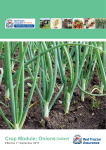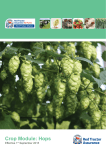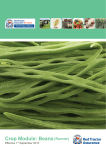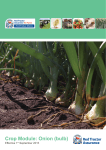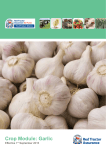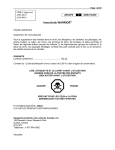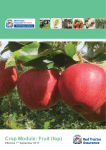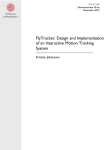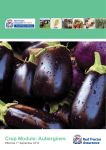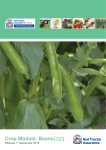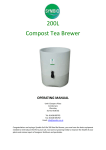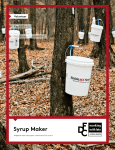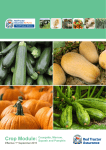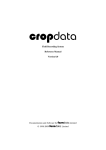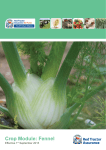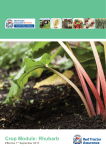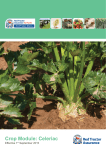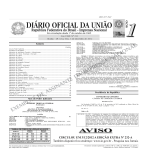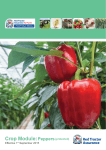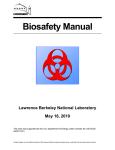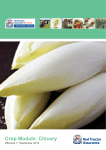Download Crop Module: Leeks - Red Tractor Assurance
Transcript
Crop Module: Leeks Effective 1st September 2015 Welcome T his crop specific module for leeks has been written to complement and avoid duplicating the generic principles of the Red Tractor Farm Assurance Fresh Produce Scheme standards. It is advisable to read the Red Tractor Farm Assurance Fresh Produce standards before reading this crop specific module. This module is designed to stimulate thought in the mind of the reader. It contains crop specific guidance and standards, where applicable, in addition to the requirements stated in the generic Fresh Produce standards. Within this module the important requirements outlined in the crop specific standards section will be verified during the Red Tractor Farm Assurance assessment and compliance will form a part of the certification/approval decision. Disclaimer and trade mark acknowledgement Although every effort has been made to ensure accuracy, Assured Food Standards does not accept any responsibility for errors and omissions. Trade names are only used in this module where use of that specific product is essential. All such products are annotated® and all trademark rights are hereby acknowledged. Notes: Pesticide Information General Introduction Following a systematic approach will help growers identify and manage the risks involved in crop production. This module is based on a typical crop production process and food safety, health & safety, environmental and quality hazards are identified. Appropriate controls may then be established to minimise risk. Food safety and health & safety issues always take precedent over quality and environmental controls. The layout of this module follows the same structure as that used in the Red Tractor Farm Assurance Fresh Produce Standards. The content of the module is reviewed prior to the issue of updated editions. The review process considers both new developments and all relevant technology which has emerged since the last review was completed and which have been found to be both workable by the grower and beneficial to the environment. The aim is to transfer such information and technologies to growers. Acknowledgements Red Tractor Assurance Fresh Produce gratefully acknowledges the contribution of all consultees in the preparation of this protocol, especially members of the Leek Growers Association and David Norman of Fresh Produce Consultancy Ltd. The Red Tractor Fresh Produce team has been working with Fera to provide tailored access to the LIAISON database for all Red Tractor Fresh Produce members. This system allows individual growers access to all information for plant protection products approved for use under the Red Tractor Fresh Produce Scheme. LIAISON can be accessed under the Produce tab via the “Checkers and Services” page where you will also find a user manual. Searches will be filtered specifically for the crops for which you are registered. Once you have logged onto the site and clicked on the LIAISON hyperlink you will be directed to the LIAISON home screen. You will need a username and password and these will be sent once you have registered: http://assurance.redtractor.org.uk/rtassurance/ services/Registration/members.eb . Front cover image credit: British Growers Association Ltd. 1 Red Tractor Assurance for Farms – Crop-specific Module: Leeks © Assured Food Standards 2015 Content Contents ADDITIONAL REQUIREMENTS AGAINST CURRENT STANDARDS 02 CROP SPECIFIC STANDARDS02 CHOICE OF VARIETY OR ROOTSTOCK AND PLANT HEALTH CERTIFICATION 03 SITE AND SOIL MANAGEMENT 03 ENVIRONMENTAL PROTECTION AND CONTAMINATION CONTROL03 PEST, DISEASE AND WEED CONTROL 04 NUTRITION 07 IRRIGATION08 HARVEST AND STORAGE 08 RESIDUES AND CONTAMINANTS 09 APPENDIX 1: TYPICAL NUTRIENT REQUIREMENTS 09 ADDITIONAL REQUIREMENTS AGAINST CURRENT STANDARDS None for this crop module CROP SPECIFIC STANDARDS STANDARDS HOW YOU WILL BE MEASURED RECORDS (to be kept for 2 years) CQ.33.a n Analysis n Soil Soil nutrient levels must be monitored prior to cropping to determine optimal fertiliser usage for phosphate, potash, magnesium and pH is especially important if fertiliser usage is to be optimised Red Tractor Assurance for Farms – Crop-specific Module: Leeks sampling records © Assured Food Standards 2015 2 GUIDANCE CHOICE OF VARIETY OR ROOTSTOCK AND PLANT HEALTH CERTIFICATION PESTICIDE APPLICATIONS MADE AT SOURCE Producers should satisfy themselves that their transplants are grown in hygienic conditions to ensure that they are planted out in a pest and disease free condition. Plant raisers should be registered with Fera Plant Health and Seeds Inspectorate under the EU Marketing Scheme. The major plant raisers have also produced, and should abide by, their own code of practice. Growers should be able to produce evidence that any propagated material has been produced within a verifiable production system. Any chemical control of pests and diseases which can be applied at the propagation stage should be used: There is no such thing as an ideal period of rotation but it is advisable not to grow onions or leeks on the same land more than one year in three. If the land has a history of disease, this width of rotation should be increased to 1 in 6 years. An additional factor that may influence rotation is the amount of trash from the crop that is left in the field. Diseases such as white tip are very often more serious where large amounts of diseased material have been left in a field and only a short rotation is practised. Crop rotation should also be considered in relation to crops susceptible to bean seed fly i.e. peas, beans, cucurbits, alliums, which may affect the risk of this pest in the following leek crop. CHOICE OF PRODUCTION SYSTEM Leeks can be grown in a variety of different ways: a. to target the problem directly, and iOver-wintered, seed drilled in late spring for harvesting from January until following May. b. to minimise usage in the field at a later date. ii Spring planted transplants for harvest in July/August. Any treatments used should be agreed with the purchaser and accurate records of application should be kept. Growers should receive records of all pesticide applications to the leek plants in the propagation stage. Only pesticides specifically recommended for use on leeks should be used by the propagator. Pesticides used under protection should have a specific recommendation for that use. Records must be kept of all pesticide applications. These records must be available for inspection. SITE AND SOIL MANAGEMENT SITE HISTORY Leeks can be grown on a wide range of soil types, but the most suitable are sandy loam to sandy clay loam, silts and high organic matter peat based soils. Leeks have a very high requirement for water, therefore land without access to irrigation should be avoided. Consideration should also be given to the fact that leeks will possibly require undercutting and harvesting in wet conditions and therefore heavier soils, especially those that drain poorly should be avoided. ROTATIONS As leeks are members of the Allium family, leeks and onions should be regarded as one and the same in respect of rotation. Certain diseases, e.g. white rot and fusarium are common to both onions and leeks and it 3 is essential to avoid over-cropping, especially where known problems exist. iiiSpring drilled from seed for harvesting from August to December. The choice of cultivar has a minor influence on disease susceptibility, there are some slight differences in rust susceptibility however, disease levels generally are encouraged by population density and prevailing weather conditions conducive to each particular disease type. ENVIRONMENTAL PROTECTION & CONTAMINATION CONTROL PLANT PROTECTION PRODUCT CHOICE APPROVED USES NOT INCLUDED ON THE PRODUCT LABEL In many circumstances, particularly for minor crops, product labels do not include all of the approved uses and growers wishing to check the approval notice of a particular product should note that this information is available using the LIAISON® search accessible via their RED TRACTOR Farm Assurance home page after logging in. A search on the ‘Extension of Authorisation for Minor Use’ page of LIAISON® by crop or product name should yield a results page. A click on the product name should link to a summary of the approval information. Near the bottom of the summary is the specific off-label number (e.g. 0246/09) and this link will open up a pdf of the current EAMU document giving details of the extension of use. Red Tractor Assurance for Farms – Crop-specific Module: Leeks © Assured Food Standards 2015 PEST, DISEASE AND WEED CONTROL PEST CONTROL Introduction The guiding principle is that pesticide inputs should be minimised through prevention rather than cure. An integrated approach should be adopted to achieve this involving the following management steps. Good management and planning a. Careful site selection to avoid potential or previous problems thereby enhancing plant health b. Sensible crop rotations to avoid build-up of problems c. Inclusion of resistant varieties (where available) in cropping programmes whilst respecting the need to meet the required quality parameters and eating requirements d. Establish the need to take corrective action by regular monitoring referring to thresholds where established. Trained staff should carry this out. The effect of prevailing weather conditions should also be considered. Cultural preventative techniques a. Good crop and field hygiene, promoting crop health by maximising nutrient availability through soil analysis and accurate application to avoid excess nutrient application b. Utilise irrigation as a control measure wherever appropriate and feasible c. Enable biological and natural methods of pest control to flourish in the crop environment. Corrective action If the above actions fail to prevent or control pests, the following approach should be adopted: a. Where corrective action is required, additional biological and natural methods of pest and disease control (if available) should be considered first b. If chemical control is needed, the following points should be considered, whilst ensuring effective control is achieved: n Use n Use the least toxic and persistent product. the most selective product to reduce the impact on naturally occurring beneficial organisms. n Use minimum effective dose rate. n Use appropriate application methods with effectively maintained equipment, and spot treating wherever possible. n Exceeding the recommended dose rate is wasteful, gives no benefit in terms of control, and is also illegal under COPR. All residues from previous Allium crops should be thoroughly destroyed or ploughed-in as soon as cropping is complete. The use of pest monitoring and forecasting techniques should be adopted where possible as an adjunct to crop inspection. Field margins can provide a reservoir of insect predators, including ladybird larvae, hoverflies, ground beetles etc. Care must be taken to avoid spray drift from the crop into these areas. Aphids Various species of aphid (black bean aphid most commonly) are seen from time to time on leek crops, especially during times when growth is rapid and the leaf is soft. Aphids do little or no damage to the leek crop and control is invariably uneconomic. Cutworms Cutworms are one of the most serious pests to attack leeks. The attacks are particularly severe in dry summers and the losses from these attacks can be substantial. The caterpillar of the turnip moth (Agrostis segetum) is responsible for the greater proportion of the damage incurred. The caterpillars feed on the roots of the leek plant causing severe damage. In the case of young seedlings, the plants are severed at the base. The turnip moths emerge during May and June and lay their eggs on the foliage. The caterpillars hatch out and initially feed on the leaves of the leek plant. They then go down to the soil and once they have entered the soil are almost impossible to kill. Attacks are often most serious on light soils. Monitoring the arrival of the turnip moth is best done with pheromone traps. This method provides an excellent guide to risk assessment. If the information gained by using the traps is used in conjunction with weather data such as temperature and rainfall, accurate control of the pest by sprays or irrigation can be timed precisely. Cultural control: Keeping the crop weed free will help discourage cutworm attacks. Cutworms are well controlled by irrigation. Irrigation should be applied while the young caterpillar is still feeding on the aerial parts of the plant. Once the caterpillar has entered the soil, no amount of irrigation will control it successfully. At least 10mm of irrigation should be applied to obtain satisfactory control of this pest. Red Tractor Assurance for Farms – Crop-specific Module: Leeks © Assured Food Standards 2015 4 Chemical control: Chemicals currently approved for the control of cutworm on leeks can be found on LIAISON®. The chemicals should be applied before the caterpillars enter the soil. Chemical applications should be made when cutworm warnings are given and routine applications of pesticides should be avoided at all costs. Stem eelworm Although a comparatively rare pest of leeks, stem eelworm (Ditylenchus dipsaci) can occasionally be a problem in intensive vegetable growing areas, especially where onions, carrots or parsnips have been grown in the same rotation. Bean seed fly (Delia platura) The amount of damage to germinating leek seedlings caused by the larvae of this pest has increased in recent years. Later drilling, largely due to the introduction of hybrid leeks, seem to suit this opportunist pest. Cultural control: As nematodes become dormant and are able to survive on infested plant tissue, it is important to remove as much trash from the field as is practical. Rotation will also help as it restricts the build-up of the pest. Predictive soil testing will help establish where high numbers may cause problems. Cultural control: The larvae of the bean seed fly are attracted by decaying trash. Avoid drilling leeks in situations where this is likely to occur. Chemical control: Treatment of the seed with tefluthrin offers useful control of both bean seed fly and onion fly. Leek moth Attacks from leek moth (Acrolepiopsis assectella) are rare and tend to occur in coastal regions in the south and east. There is very rarely any need for treatment and no chemical is specifically recommended for this pest. Insecticides, which are used for cutworm or thrip control, will give some level of control of this pest. Onion fly Onion fly (Delia antigua) can be a serious pest of drilled leeks. The bean seed fly (Delia platura) which is a close relative of the onion fly also causes damage. Although the most serious damage is caused to young seedling leeks, these flies can also cause significant damage to more mature crops. Cultural control: A good rotational policy will help reduce the severity of attacks from onion fly. Keeping the amount of organic debris on the soil surface down will also reduce the amount of attacks. However, there is no really successful method of reducing attacks by the maggots of this pest, as attacks are sporadic and unpredictable. Chemical control: Treatment of the seed with tefluthrin offers useful control of both bean seed fly and onion fly. Spider mite The two-spotted spider mite (Tetranychus urticae) is seen on leek crops, especially in hot, dry summers. Although the pest can cause damage in isolated patches, it does not warrant treatment. Chemical control: There is no chemical control available at the present time. Thrips The onion thrip (Thrips tabaci) has become a serious pest of leeks in recent years and is one of the most difficult pests to control satisfactorily. Damage can occur very early in the life of the crop, almost before it is noticed. Early treatment is advised, as established colonies can be difficult to eradicate. Thrip damage is worst in hot dry weather when the crop is growing slowly, it is less of a problem in wet seasons. Cultural control: Very little can be achieved in respect of cultural control. Although rotation will help to a certain extent, there is no guarantee that crops grown on virgin land will be unaffected. Overhead irrigation discourages the pest. Chemical control: The new spinosad material, ‘Tracer’, offers the good chemical control of this pest as does ‘Agrimec’ -Abamectin. Dursban WG will also help control the pest early in the leek growth stage. The use of a silicon wetter may improve control of all products. Lambda cyhalothrin may also help control this pest and an EAMU to cover the use of this chemical has been issued. It has been established by Rothhamsted and HRI Warwick research that thrips have become resistant to pyrethroids and therefore should be used sparingly. DISEASE CONTROL Introduction The guiding principle is that pesticide inputs should be minimised through prevention rather than cure. An integrated approach should be adopted to achieve this involving the following management steps. Cultural control: The best method of control is rotation and hygiene as this pest overwinters on debris in the soil. There are a number of predators, which attack this pest that is why careful consideration should always be given to application of pesticides that will have an effect upon these predators. 5 Red Tractor Assurance for Farms – Crop-specific Module: Leeks © Assured Food Standards 2015 Good management and planning a. Careful site selection to avoid potential or previous problems thereby enhancing plant health b. Sensible crop rotations to avoid build-up of problems c. Inclusion of resistant varieties (where available) in cropping programmes whilst respecting the need to meet the required quality parameters and eating requirements d. Establish the need to take corrective action by regular monitoring referring to thresholds where established. Trained staff should carry this out. The effect of prevailing weather conditions should also be considered. Cultural preventative techniques a. Good crop and field hygiene, promoting crop health by maximising nutrient availability through soil analysis and accurate application to avoid excess nutrient application b. Utilising irrigation as a control measure wherever appropriate and feasible c. Enable biological and natural methods of disease control flourish in the crop environment. Corrective action If the above actions fail to prevent or control diseases, the following approach should be adopted: a. Where corrective action is required, additional biological and natural methods of disease control (if available) should be considered first b. If chemical control is needed, the following points should be considered, whilst ensuring effective control is achieved: n Use the least toxic and persistent product. n Use the most selective product to reduce the impact on naturally occurring beneficial organisms. n Use minimum effective dose rate. n Use appropriate application methods with effectively maintained equipment, and spot treating wherever possible. n Exceeding the recommended dose rate is wasteful, gives no benefit in terms of control, and is also illegal under COPR. All residues from previous Allium crops should be thoroughly destroyed or ploughed-in as soon as cropping is complete. The use of disease monitoring and forecasting techniques should be adopted where available as an adjunct to crop inspection, thus minimising fungicide use. Disease levels are minimised by good rotations. Where land is over cropped with leeks, there is a likelihood that disease levels will increase. On many farms, leeks are present in the ground for twelve months of the year. Leeks drilled in March will be emerging before the crop planted or drilled the previous season, has been harvested. As a consequence, there is often a source of inoculum to infect the new crop with white tip, leek rust, thrips etc. As long a rotation as possible and practical should be allowed between crops. Siting mature crops away from newly emerging crops will help to reduce the risk of disease. Disease is frequently carried over on leek trash. Where most trimming is carried out in the packhouse, ensure that the waste is not transferred back to fields intended for leek production. Where rigs are used to harvest the crop, thought should be given to ways of removing at least some of the waste crop unless a very long rotation can be practised. Seedling diseases Diseases such as damping off are to some extent controlled by seed treatments. Seed treatment is an environmentally sound way of controlling diseases. Seed suppliers should be consulted as to which materials or combination of materials are suitable for a particular purpose. Foot rot (Fusarium culmorum) Hot summers combined with an intensity of cropping will accentuate this disease. When the leek is pulled, it is often rotten and the base and stems often have a distinct pink colour. It is particularly important when planting bare root transplants to ensure that the plants come from a seedbed which is free from Fusarium. Leaf blotch (Cladosporium allii) A disease encouraged by damp, mild weather and short day length. It can be effectively controlled if treated in the early stages with Triazole fungicides. Purple blotch (Alternaria porri) This disease is sometimes confused with leaf blotch, as the symptoms are somewhat similar. The individual blotches develop a purple centre. The disease has become more prevalent in leek crops in recent years. It is rarely a disease of economic importance although fungicides used for other diseases will have a suppressant effect upon it. The fungicide based on azoxystrobin, pyraclostrobin and trifloxystrobin will also offer some control of this disease. Red Tractor Assurance for Farms – Crop-specific Module: Leeks © Assured Food Standards 2015 6 Rust (Puccinia allii) This is possibly the most serious disease of leeks. Some varieties are more sensitive to the disease than others. The disease tends to be worse in coastal or wetter areas although all areas of the UK experience this problem to a greater or lesser extent. It is important to diagnose rust in the very early stages, as there are some effective fungicides that will offer good control of the disease, and good choice of nozzles is essential for application efficiency. It is extremely important to alternate fungicides from different chemical groups when treating rust, as this will help to avoid resistance to a particular compound. Treatments may be selected from approved products via LIAISON® White tip (Phytophthora porri) A disease that is endemic on land which has a long history of leek growing. However, it can occur on new land, although this is less common. It is especially important to avoid badly drained areas, as this is often where the disease starts. Good rotations will help reduce disease levels and it is particularly important to remove as much trash as possible from the field as the disease will carry over in the soil. This is however, a serious disease of over-wintered leeks and one for which this is limited effective chemical control. There are now a number of fungicides which offer some control of this disease. It is important when applying these fungicides, to alternate the chemical group to which these fungicides belong, in order to minimise resistance. White rot (Sclerotium cepivorum) Although not as susceptible as onions, this disease can seriously affect crops in situations where there is a history of the disease. There is no chemical cure and the only way of avoiding this disease is not to grow crops where there is a history of white rot. Even long rotations are no guarantee of avoiding the disease. Weed control Leeks do not offer much crop competition to weed development because of the nature of their growth. If weeds are not kept under control they can cause severe crop competition and difficulty will be experienced with harvesting, especially mechanical harvesting. There is a wide range of approved herbicides available which have a label recommendation for leeks. These can be found from LIAISON®. When applying herbicides to the leek crop, especially direct drilled leeks, it should be born in mind that repeat low doses of herbicides are often the most effective way of controlling early weed growth. Applying repeat low doses of herbicide will often do less damage to the crop than applying products at the recommended dose. 7 Cultural control: Mechanical methods of weed control are often complementary with the use of herbicides. Direct drilled crops of leeks, which are in the ground for several months, need sequential herbicides to maintain good weed control. The use of mechanical cultivations can reduce the number of herbicide applications that have to be made to the crop. Operations such as hoeing or ridging also prevent capping on some soils, thereby allowing better distribution of fertiliser that has been applied to the crop. Also where crop earliness is important or weeds outside spectrum of current chemistry hand weeding is performed. On certain soils that are prone to capping, cultivations help prevent anaerobic conditions occurring just below the soil surface. NUTRITION TRANSPLANT PROPAGATION Propagation is done in blocks, modules, or as bare root transplants. The latter can be under protection or in an outdoor seedbed. Correct attention in respect of watering and nutrition should be given at all times. It is particularly important that modules or blocks are moist when they are despatched from the nursery. In particular modules are very prone to drying out as they generally contain less compost than blocks. Once modules or blocks have dried out, they are very difficult to re-wet and failure to ensure adequate moisture content before planting can lead to serious plant losses. Nutrient analysis Soil analysis for phosphate, potash, magnesium and pH is especially important if fertiliser usage is to be optimised. Soil nutrient levels must be monitored during the life of the crop are monitored by carrying out leaf/sap analysis. Nitrogen Leeks are responsive to nitrogen. The majority of the plant’s requirement should be applied post-drilling or post-planting. Large amounts of nitrogen applied to the seedbed are not only wasteful and environmentally unsound; they can also inhibit germination. Applications of nitrogen applied to over-wintering crops in late autumn should be avoided as the plant is unable to utilise nitrogen efficiently during the late autumn and winter, and Nitrogen cannot be applied in the closed period. Top dressing can be applied in the spring when growth commences. Care should be exercised when applying nitrogen top dressing to the leek crop. Broadcast applications may result in granules lodging in the crop and scorching the leaves of the leeks. Red Tractor Assurance for Farms – Crop-specific Module: Leeks © Assured Food Standards 2015 Over-application of nitrogen can result in very soft crops that are very prone to disease, especially rust, they may also be more susceptible to frost damage. Copper Tips of young leaves become chlorotic, turn white and twist or spiral. Phosphate and potash Both phosphate and potash should be applied according to soil analysis. Both should be applied pre-planting or pre-drilling according to the table in Appendix 1. Zinc Leaves striped yellow, twisted and stunted. Magnesium Magnesium is an important element in leek production, especially on light sandy soils. Magnesium should be applied in the spring at least three weeks before planting or drilling. The best form of magnesium to use is kieserite because it is so readily available to the plant. It is possible to obtain kieserite in granular form. If lime is required in addition to magnesium, it may be more cost effective to apply magnesian limestone. However, magnesian limestone often takes longer to correct pH than does ground limestone. pH Leeks are very sensitive to soil acidity. They grow best at a pH of between 6.5 and 7.0 on mineral soils. On peaty soils the pH will generally not restrict growth unless below 6.0. Results given by a laboratory on a composite sample can be misleading and the best way to check pH is by GPS grid sampling. Acid patches can be readily identified with the help of a suitable soil indicator. Unless there is a very well defined and isolated acid patch, soils are best limed according to their lowest pH. Sampling should be carried out in the spring as on some soils winter rainfall can significantly reduce the pH. TRACE ELEMENTS Manganese Leeks usually suffer from manganese deficiency: occasionally this is induced by over-liming. Manganese deficiency can be confirmed by leaf analysis and is best corrected by an application of manganese sulphate or a suitable chelated product. Other trace element deficiencies are Molybdenum, Boron, Sulphur, Copper, Zinc and Calcium, these are rare in the UK but can sometimes occur. Molybdenum Poor emergence and seedling death. On mature plants tips die and there is a wilted zone between the dead tip and healthy tissue. Boron Transverse cracks on leaves. Sulphur Leaves stiff and erect, early swelling of stem base. Calcium Leaves very narrow and die back abruptly from tips without first yellowing. All deficiencies should be based on soil analysis, soil type and tissue analysis (guide only can be variable). IRRIGATION Leeks should have adequate soil moisture if they are to bulk satisfactorily. Lack of soil moisture at certain times of the year can lead to bulbing. Irrigation at drilling In particularly dry periods it may be necessary to apply irrigation in order to help the leek seed to germinate. Once irrigation has commenced, it will be necessary to continue to keep the soil moist until the entire crop has emerged. The radical of the germinating leek plant is very sensitive to drying out. The following should also be borne in mind: n On soils, which are known to cap when irrigated, it is worth using an anti-capping material immediately after the seed has been sown. n Apply irrigation ‘little and often’ rather than in doses which might do damage to the structure of the seedbed. Newly planted seedlings, especially those planted behind a dibbing machine, require watering as soon as possible after planting. It is more cost effective to apply water to newly planted leeks directly along the rows and down the dibbing holes rather than by using overall irrigation. It is worth considering monitoring water status in the growing crop. This can be achieved by various methods such as electrical capacitance probes, neutron probes, tensiometers or simple water balance sheets etc. Irrigation timing and an indication of the amount of water to be applied can be judged more effectively if some monitoring system is employed. This can result in more efficient and economical use of irrigation. HARVEST AND STORAGE Leeks are sometimes undercut before lifting. Care should be exercised to ensure that the undercutter is set to the correct depth so as not to damage the base plate of the leeks. Red Tractor Assurance for Farms – Crop-specific Module: Leeks © Assured Food Standards 2015 8 The leeks are sometimes trimmed mechanically prior to lifting. Care should be taken that this operation is not carried out too far in advance otherwise de-lamination of the leeks may take place. PACKHOUSE AND FIELD RIGS Washing should take place initially in fresh or re-circulated water. The final rinse must be in water that is of a potable standard. A microbiological analysis of the final washing water should be carried out. Make sure that water used for washing harvested product is adequately cleaned and conservation of water is undertaken. No chemical additives should be added to the washing water. Leek waste should not be spread on fields where leek production is destined to take place, as this will encourage the spread of diseases such as white tip, waste leaves are best returned to same field from which those leeks were harvested, or placed on some designated land that will never be cropped with alliums. Cooling Leeks should be stored at between 2° and 10°C prior to despatch. Storage During the months of May and June it is becoming common practice to place leeks in refrigerated and/or controlled atmosphere stores. It is important that the store is dedicated to leeks as storing other fresh produce in the same store may lead to rapid deterioration of the leeks. RESIDUES AND CONTAMINANTS Red Tractor Farm Assurance Fresh Produce is aware that a key area in the production of fresh produce which requires continued attention by growers and their advisers is that of keeping pesticide residues to a minimum. The issue is not just one of meeting the MRL trading standard but ensuring that any individual or multi residues are kept as low as possible below this level. The key targets are: n Optimising late application of fungicides insecticides to the edible part of the crop n Optimising n Ensuring followed and the use of post-harvest treatments at the least, minimum harvest intervals are n Ensuring that application equipment is applying products correctly Currently there are no residue issues associated with this crop but the awareness needs to be maintained for any future issues. APPENDIX 1: TYPICAL NUTRIENT REQUIREMENTS Typical nutrient requirements for leeks – Ref RB209 8th Edition Nutrient (kg/ha) Soil SNS, P, K, Mg Index 0 1 2 3 4 5 6 Nitrogen (a) 200 190 170 160 130 80 40 Phosphate (b) 200 150 100 50 b b b Potash 275 225 175 (2-) 125 (2+) 50 0 0 0 Magnesium 150 100 0 0 0 0 0 Only a small amount of nitrogen should be applied in the seedbed for drilled crops, commonly 40-60kg/ha. For transplants a higher amount can be applied in the seedbed, up to 100kg/ha, while for early season fleece covered transplants all the Nitrogen may be applied in the seedbed. For autumn harvested crops the remaining Nitrogen should be applied as a top dressing which should be split into 2-3 applications, applied during the summer months. For over-wintering crops to be harvested after March only apply part of the total nitrogen in the summer months keeping back the final top-dressing for the spring. At P indices of 4 and above up to 60kg/ha P applied as a starter fertiliser at drilling may be justified, especially on light textured soils. 9 Red Tractor Assurance for Farms – Crop-specific Module: Leeks © Assured Food Standards 2015 Certification Bodies Your routine point of contact with the Scheme is through your Certification Body. Certification Bodies are licensed by Red Tractor to manage membership applications and to carry out assessment and certification against the Standards. The table below shows which Certification Bodies apply to each enterprise. Certification Body NSF Kiwa PAI SAI Global SFQC Beef and Lamb Dairy Combinable Crops and Sugar Beet Fresh Produce 4 4 4 4 4 4 4 4 4 4 4 4 4 4 4 4 NIFCC (Northern Ireland) 4 QWFC (Wales) 4 Pigs Poultry 4 4 4 4 4 4 4 NSF Certification Kiwa PAI Hanborough Business Park Long Hanborough Oxford OX29 8SJ Tel: 01993 885739 Email: [email protected] Web: www.nsf-foodeurope.com The Inspire, Hornbeam Square West, Harrogate, North Yorkshire HG2 8PA Tel: 01423 878878 Email: [email protected] Web: www.kiwa.co.uk/pai SAI Global Assurance Services Ltd PO Box 6236, Milton Keynes MK1 9ES Tel: 01908 249973 Email: [email protected] Web: www.saiglobal.com/assurance QWFC SFQC Ltd NIFCC [Northern Ireland] QWFC [Wales] Royal Highland Centre, 10th Avenue, Ingliston, Edinburgh EH28 8NF Tel: 0131 335 6605 Email: [email protected] Web: www.sfqc.co.uk Lissue House, 31 Ballinderry Rd, Lisburn, Northern Ireland BT28 2SL Tel: 028 9263 3017 Email: [email protected] Web: www.nifcc.co.uk PO Box 8, Gorseland, North Road Aberystwyth SY23 2WB Tel: 01970 636688 Email: [email protected] Web: www.wlbp.co.uk T: 01932 589 800 E: [email protected] www.redtractorassurance.org.uk Fresh Produce Standards












